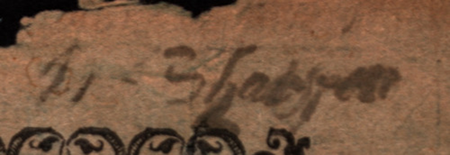50 Megapixel Imaging System Uncovers Billy Shakespeare’s Signature. Renaissance Swag!
Now this is a way to spend a spring fucking break if you’re a literature nerd like me. A professor at the University of Mississippi took his students down to Washington D.C. and they went and discovered themselves Billy Shakespeare’s signature.
I Heart Chaos:
Using a 50-megapixel multispectral digital imaging system, University of Mississippi English professor Gregory Heyworth and his students, Andrew Henning, Mitchell Hobbs, and Kristen Vise, spent their spring break in Washington, D.C. at the Folger Shakespeare Library imaging a faint signature in a copy of “Archaionomia,” a survey of Saxon laws published during the reign of England’s Queen Elizabeth I and they now think they’ve finally seen Shakespeare’s signature.
The signature in the book had been identified as possibly being in Shakespeare’s hand in 1942, though some suspected it to be a forgery.
Like an archaeologist, Heyworth takes pains to state in no uncertain terms that it may never be possible to prove beyond a shadow of a doubt that it is by Shakespeare. However, if the spectral fingerprinting they did on this signature is consistent across other known signatures, it would come very close to definitive proof. If, however, it is consistent with known forgeries, that too would be a near-definitive judgment.
“The so-called Lambarde signature on the Archaionomia that we imaged was suspected by its first owner in the 1940s of having been by famed 18th century forger William Henry Ireland,” Heyworth told Ars. “We know that Ireland used a special formulation of ink combined with acid and paper-marbling fluid for all his forgeries. Inks all refract light differently, according to their chemical composition. Multispectral imaging, then, combined with spectral analysis of particular spots, yields data indicating the unique refraction of light at various wavelengths. I call this a multispectral fingerprint, although it is not as exact.”
“We are returning tomorrow to the Folger to have a look at the multispectral fingerprints of known forgeries of William Ireland and compare them to the Lambarde,” he said. “In general, we are particularly interested in refining our use of multi-spectral fingerprints as a tool for authentication and provenance.”
If the signature turns out to be Shakespeare’s, it may shed light on the man himself.
“For one,” said Andrew Henning, a student of English and mathematics on the Lazarus team, “it suggests that, at the very least, Shakespeare possessed and was actively reading legal texts. Some might even argue that it draws a strong line indicating that Shakespeare was in some way involved in the English legal system.”
Love this. There’s a certain allure to identifying heroes of the past in nebulous places. Finding new letters written, or signatures, or discarded dump-covered manuscripts in the corpse of an ex-lover’s stomach all seem to titillate us. We miss our heroes, and anything new that could present a new side or moment in their brief existence gives us a boner. Well played, U. of Miss people.




